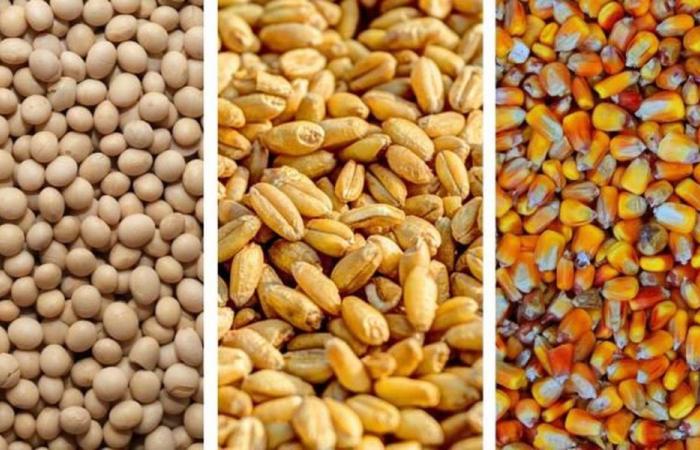World prices of food products continued to decline, reflecting an improvement in supply, indicates the DEPF, which reports to the Ministry of the Economy and Finance in its latest economic note for the month of September.
In August, the FAO Food Price Index stood at 120.7 points, marking a decline of 0.3% month-on-month, 1.1% year-on-year and 25% since its historic peak in March 2022, specifies the same source.
Year-on-year, the fall in prices of cereals (-12%) and sugar (-23%) contrasts with the increase in dairy products (+14%), vegetable oils (+8%) and meat (+ 4%).
Over the first eight months of 2024, the FAO index fell by 5.6% compared to the same period in 2023, due to the decline in prices of cereals (-15%), sugar (-10% ) and dairy products (-2.3%), despite a slight increase in vegetable oils (+0.7%) and meat (+0.2%).
However, after reaching multi-year lows in August, food prices started to rise again, driven by concerns about climatic hazards. The rebound is more marked for wheat and sugar.
The courses of soft wheat (SRW) stood at $206 per tonne on average in August, their lowest level since the summer of 2020, marking a fall of 6% over one month and 19% since the start of 2024.
Over the first eight months of the year, the average price of wheat settled at $232 per tonne, down 15% year-on-year, thanks to ample supplies, weak global demand and increased competition among exporters.
Despite the collapse of the Black Sea grain initiative, Ukraine continued to export via sea corridors and new land routes.
However, wheat prices rebounded 17% from their multi-year low on August 26 to reach $230 per tonne on September 13, their highest level in three months. This rise is fueled by fears of a tightening of supplies from the Black Sea region, exacerbated by concerns about sowing in Russia and Ukraine, affected by difficult climatic conditions. Overall, global wheat supplies appear to be shrinking, leading to tighter stocks.
According to the FAO, world wheat production for the 2023-2024 campaign, estimated at 789 million tonnes (Mt), is down 18 Mt (-2.2%) compared to the previous season’s record of 807 Mt. (+3.4%). The decline in harvests in Australia, Kazakhstan, Canada and Brazil contrasts, however, with the increase observed in India, the United States, Argentina and Ukraine.
For the 2024-2025 campaign, the FAO forecasts a slight recovery in world wheat production, reaching 791 Mt (+0.4%), which would make it the second largest harvest after the record of 2022-2023.
Expected production increases in Australia, the United States, Kazakhstan, India, China, Argentina and Canada would offset expected declines in the European Union, Russia, the United Kingdom and Ukraine.
According to the USDA, wheat production is expected to decline significantly in the EU (-11 Mt to 124 Mt) and Russia (-8.5 Mt to 83 Mt), due to unfavorable weather conditions.
THE corn price posted an average of $170 per tonne in August, their lowest since September 2020, down 4% over one month and 18% since the start of 2024.
Over the first eight months of 2024, corn prices recorded an average of $189 per tonne, down 30% year-on-year.
This fall is explained by abundant supply and weak demand, particularly in China, where economic uncertainties have affected imports. In addition, although ethanol production from corn is increasing, it has not been enough to absorb the large stocks.
According to the FAO, world corn production for the 2023-2024 campaign reached a record 1,240 Mt, up 69 Mt (+6%) compared to the previous season, thanks to abundant harvests in the United States, in Argentina, China, Ukraine and the EU, despite declines observed in Brazil, Mexico and South Africa. For the 2024-2025 season, global production is expected to decline to 1,225 Mt (-1.2%), due to lower harvests in Ukraine, Russia and the EU, affected by heat and drought, as well as in the United States, where the reduction in cultivated areas would compensate for record yields. On the other hand, the outlook remains favorable for Brazil, South Africa, China, Mexico and Argentina.
THE soybean price stood at $400 per tonne on average in August, their lowest level in four years, marking a fall of 15% over one month, 27% since the start of 2024 and 31% over one year.
Over the first eight months of the year, soybean prices averaged $484 per tonne, down 21% year-on-year. This sharp decline is due to abundant supplies and forecasts of record harvests, particularly in the United States, where favorable weather conditions in the Midwest point to exceptional production.
According to the FAO, global soybean production for 2023-2024 reached a record 393 Mt (+4%), mainly thanks to a strong rebound in production in Argentina, supported by the El Niño phenomenon, despite declines in Brazil and in the United States. For 2024-2025, global production is expected to reach a new record of 424 Mt (+7.8%), thanks to promising harvests in the United States, Brazil and Argentina.
China remains the main importer of soybeans, with an estimate of 112 Mt for the 2023-2024 campaign, representing 63% of global trade.
In August, raw sugar prices (ISA) fell 4% over one month and 23% over one year, reaching $406 per tonne, their lowest level since October 2022.
Over the first eight months of 2024, the average price recorded $448 per tonne, down 10% year-on-year.
The decline is supported by an improvement in production prospects for the 2024-2025 season in India (9%) and Thailand (10%), thanks to favorable rainfall for sugar cane crops.
The downward pressure on sugar prices is accentuated by the decline in oil prices and by concerns linked to weak demand from China, one of the main importers.
However, sugar prices rebounded 26% from their August 20 low ($388) to reach $489 on September 20, their highest level since April, following concerns about drought and fires that affected sugar prices. sugar cane crops in São Paulo, one of the main sugar regions in Brazil, the world’s largest producer.
According to the USDA, sugarcane production in Brazil is expected to decline by 8.5% to 645 Mt in 2024-2025 due to dry weather conditions, after reaching a record 705 Mt in 2023-2024.
Despite this, sugar and ethanol production should remain stable thanks to unused stocks from the previous season.
In this wake, the International Sugar Organization (ISO) forecasts a significant deficit in global supply of 3.6 Mt in 2024-2025, due to a drop in production (-1.1% to 179, 3 Mt), while consumption would reach 182.9 Mt. This deficit far exceeds that of 2023-2024 (estimated at 0.2 Mt vs. 3 Mt initially).






